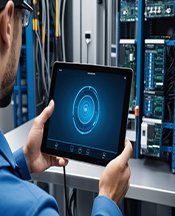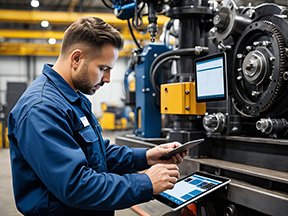Published: July 23, 2015 | Updated: September 18, 2025
Published: July 23, 2015 | Updated: September 18, 2025
The Internet of Things: Revolutionizing Facility Management
 The "Internet of Things," or IoT, represents a significant technological shift with profound implications across numerous sectors, particularly facility management. While the term might sound abstract to those unfamiliar with the intricacies of modern technology, its core concept is surprisingly straightforward: everyday objects gain the ability to connect to the internet and communicate with other devices. Let's discuss IoT and how it can revolutionize facility management.
The "Internet of Things," or IoT, represents a significant technological shift with profound implications across numerous sectors, particularly facility management. While the term might sound abstract to those unfamiliar with the intricacies of modern technology, its core concept is surprisingly straightforward: everyday objects gain the ability to connect to the internet and communicate with other devices. Let's discuss IoT and how it can revolutionize facility management.
Consider a simple yet illustrative example: a standard door. When equipped with IoT capabilities, this door transcends its basic function of providing security and access control. Through internet connectivity, a facility manager can remotely lock or unlock it via a computer or mobile device.
This seemingly minor enhancement unlocks a cascade of possibilities for enhanced security protocols, access management, and operational oversight. Current applications of IoT technology already permeate our daily lives, evident in:
- Security systems that send real-time alerts
- Smart thermostats that learn user preferences and adjust temperatures automatically
- Intelligent home lighting systems controllable via apps.
- Advanced vehicle control systems offering features like remote start and diagnostics
- Interconnected home appliances that can be monitored and managed remotely.
The Multifaceted Advantages of IoT for Facility Managers
For facility managers, the integration of IoT technologies unlocks a wealth of benefits, chief among them the power of automation. The IoT facilitates the automation of routine tasks and the seamless synchronization of equipment operations with Computerized Maintenance Management Systems (CMMS).
This integration provides facility managers with a centralized digital dashboard, offering comprehensive control over a property's critical systems, from heating, ventilation, and air conditioning (HVAC) units to intricate security networks. This unified view empowers proactive decision-making and efficient resource allocation.
Driving Energy Efficiency through Smart Systems
On a more granular level, the IoT plays a crucial role in reducing energy consumption within manufacturing plants and commercial facilities. Smart systems, powered by embedded sensors, enable sophisticated climate control. These systems can detect minute temperature variations on a room-by-room basis and dynamically adjust airflow in specific zones.
This precise control allows HVAC systems to operate with greater efficiency to minimize energy waste and significantly lower operational costs. Imagine a scenario where an unoccupied office space automatically reduces its heating or cooling output, while adjacent areas with active personnel maintain optimal comfort levels.
Remote Monitoring and Control: Expanding Managerial Reach
The ability to monitor and manage a facility remotely represents another significant advantage offered by IoT integration. With an internet-connected device, a facility supervisor gains the power to oversee numerous aspects of their property from any location. For instance, if employees inadvertently leave lights on after hours or before a holiday weekend, the manager can simply log into the central control system and deactivate non-essential lighting and machinery without needing to be physically present. This remote access saves time, reduces unnecessary energy expenditure, and enhances overall operational efficiency.
Proactive Maintenance and Reduced Downtime
The IoT also revolutionizes equipment maintenance. When a machine operates below its optimal capacity, IoT-enabled sensors can trigger alerts sent directly to the facility manager. This allows for immediate remote assessment and potential shutdown of the equipment until a maintenance technician can address the issue.
Furthermore, intelligent machinery equipped with IoT capabilities can automatically detect anomalies and generate work orders, dispatching them directly to a maintenance worker's mobile device. This proactive approach significantly minimizes machinery downtime, enables maintenance crews to address minor issues before they escalate into major failures, and ultimately reduces the need for costly equipment replacements, leading to substantial departmental savings.
Industries Embracing the Power of IoT in Facility Management
The transformative capabilities of IoT in facility management resonate across a diverse range of industries, each leveraging its unique advantages to enhance operational efficiency, reduce costs, and improve overall performance.
Manufacturing: Precision and Predictive Maintenance
The manufacturing sector stands to gain immensely from IoT integration. Smart sensors embedded in machinery can monitor performance metrics such as temperature, vibration, and energy consumption in real time. This data allows for predictive maintenance, identifying potential equipment failures before they occur, minimizing costly downtime, and maximizing production output.
Healthcare: Enhanced Patient Comfort and Safety
In healthcare facilities, IoT devices contribute to enhanced patient comfort and safety. Smart HVAC systems maintain optimal environmental conditions, while connected medical equipment allows for remote monitoring and timely maintenance. Real-time location services (RTLS) powered by IoT can track the movement of critical assets and personnel, improving efficiency and security. Companies such as Johnson Controls and Philips Healthcare provide IoT solutions for the healthcare industry.
Discover how streamlined maintenance processes can elevate production. Learn more.
Commercial Real Estate: Smart Buildings and Tenant Experience
Commercial real estate benefits from IoT through the creation of smart buildings. Connected lighting systems adjust based on occupancy, smart thermostats optimize energy usage, and intelligent security systems enhance building safety. These technologies also contribute to an improved tenant experience. Companies like Honeywell and Schneider Electric offer a wide array of IoT solutions for commercial buildings.
Hospitality: Personalized Guest Experiences and Operational Efficiency
The hospitality industry utilizes IoT to personalize guest experiences and improve operational efficiency. Smart room controls allow guests to adjust lighting and temperature to their preferences, while connected sensors can monitor room occupancy for efficient cleaning schedules and energy management. Companies such as Hilton and Marriott are exploring and implementing various IoT technologies in their properties.
 The Synergistic Relationship Between CMMS and IoT
The Synergistic Relationship Between CMMS and IoT
The true power of IoT in facility management amplifies significantly when integrated with a Computerized Maintenance Management System (CMMS). A CMMS acts as a central hub for managing maintenance activities, tracking assets, and scheduling work orders. When connected to IoT devices, the CMMS gains access to a continuous stream of real-time data from sensors and equipment. This integration moves maintenance strategies from reactive to proactive and even predictive.
Real-Time Data for Informed Decision-Making
IoT sensors provide the CMMS with up-to-the-minute information on equipment performance, environmental conditions, and building occupancy. This data allows facility managers to make informed decisions based on actual conditions rather than relying on scheduled inspections or reactive maintenance. For example, a sudden increase in a machine's temperature, detected by an IoT sensor, can automatically trigger an alert within the CMMS, prompting immediate investigation.
Predictive Maintenance Capabilities
The continuous data stream from IoT devices enables sophisticated predictive maintenance strategies within the CMMS. By analyzing trends and patterns in sensor data, the CMMS can identify potential equipment failures before they occur. This allows for scheduled maintenance interventions, minimizing unexpected downtime and extending the lifespan of critical assets. This proactive approach translates directly into significant cost savings and improved operational reliability.
The convergence of the Internet of Things and facility management marks a pivotal evolution in how buildings and infrastructure operate. It shifts the paradigm from reactive responses to proactive interventions, fostering environments that are more efficient, safer, and ultimately more cost-effective. This technological synergy empowers facility managers with unprecedented levels of control and insight, paving the way for a future where intelligent systems anticipate needs and optimize performance autonomously.
FAQs
What is the Internet of Things (IoT) in facility management?
IoT connects everyday devices to the internet, enabling remote monitoring and control of building systems.
How does IoT improve energy efficiency?
Smart sensors adjust HVAC, lighting, and other systems based on real-time occupancy and environmental data, reducing energy waste.
Can IoT reduce equipment downtime?
Yes, IoT sensors detect anomalies and trigger alerts or work orders, allowing proactive maintenance and minimizing failures.
How does IoT integrate with CMMS?
IoT streams real-time data to a CMMS, enabling predictive maintenance, automated alerts, and better decision-making.
Which industries benefit most from IoT in facility management?
Manufacturing, healthcare, commercial real estate, and hospitality all leverage IoT to improve efficiency, safety, and cost savings.
What advantages does MAPCON CMMS offer when combined with IoT?
MAPCON CMMS centralizes maintenance, tracks assets, and uses IoT data for proactive and predictive maintenance strategies.
MAPCON | 800-922-4336
MAPCON CMMS software empowers you to plan and execute PM tasks flawlessly, thanks to its wealth of features and customizable options. Want to see it for yourself? Click the button below to get your FREE 30-day trial of MAPCON!
Try It FREE!